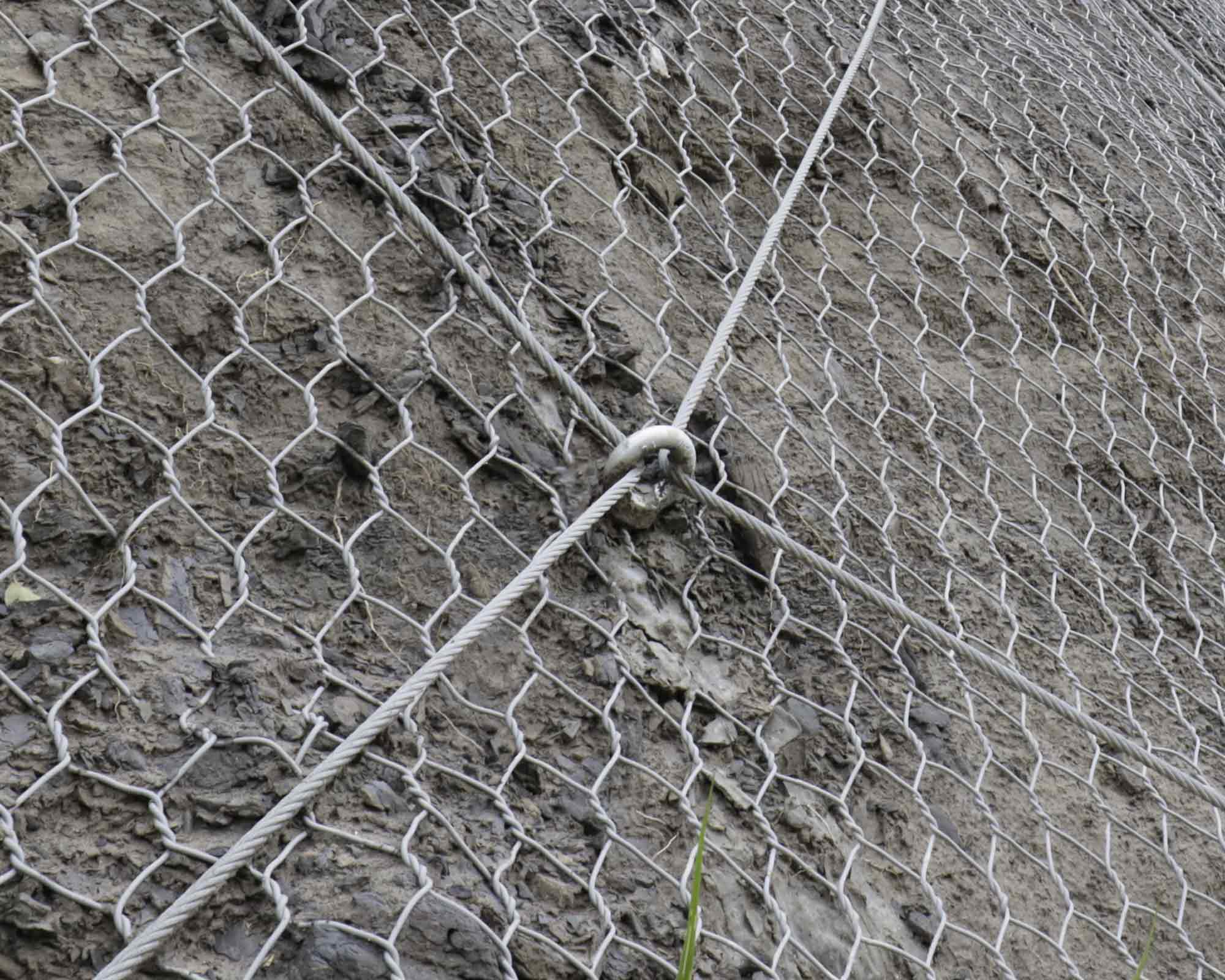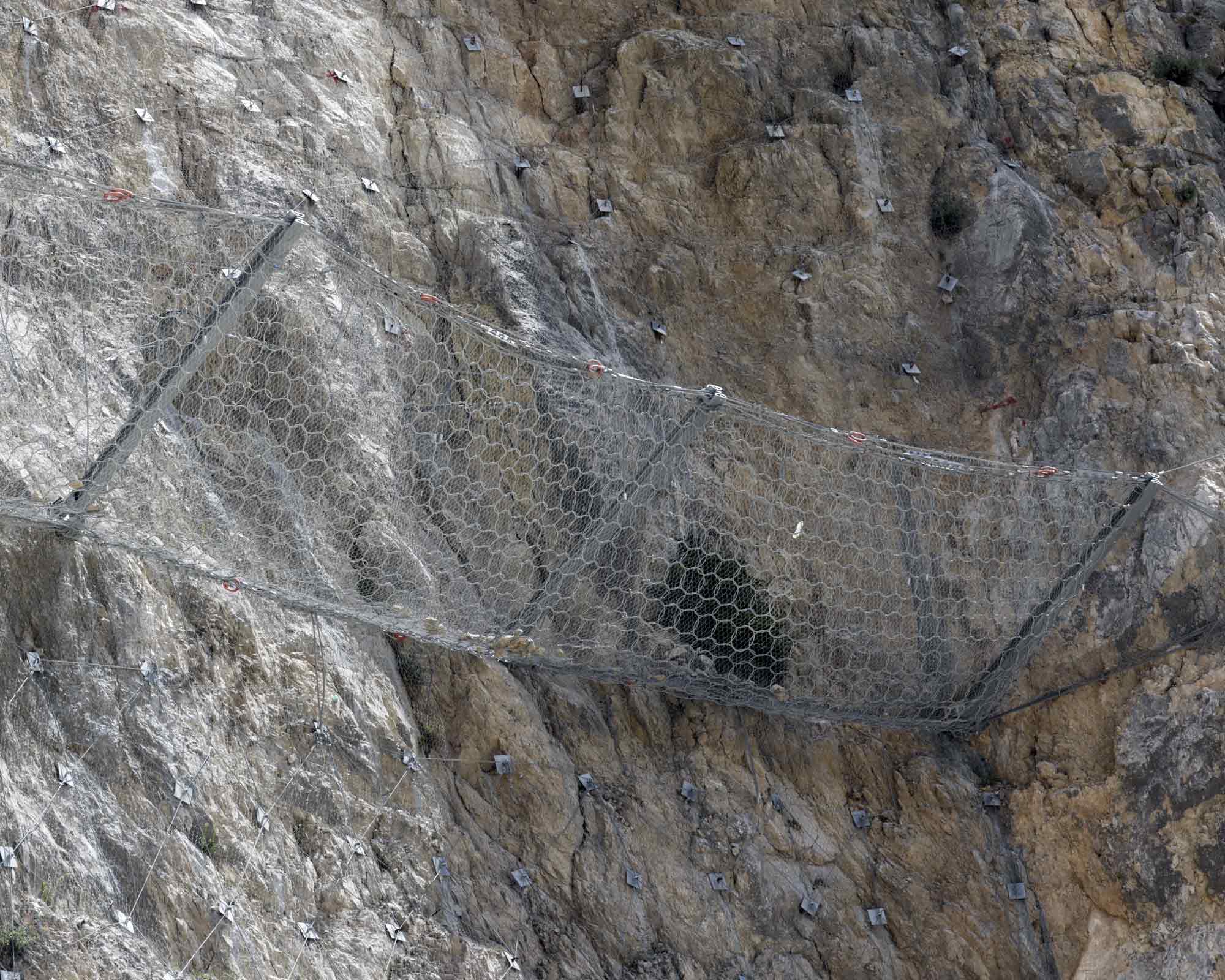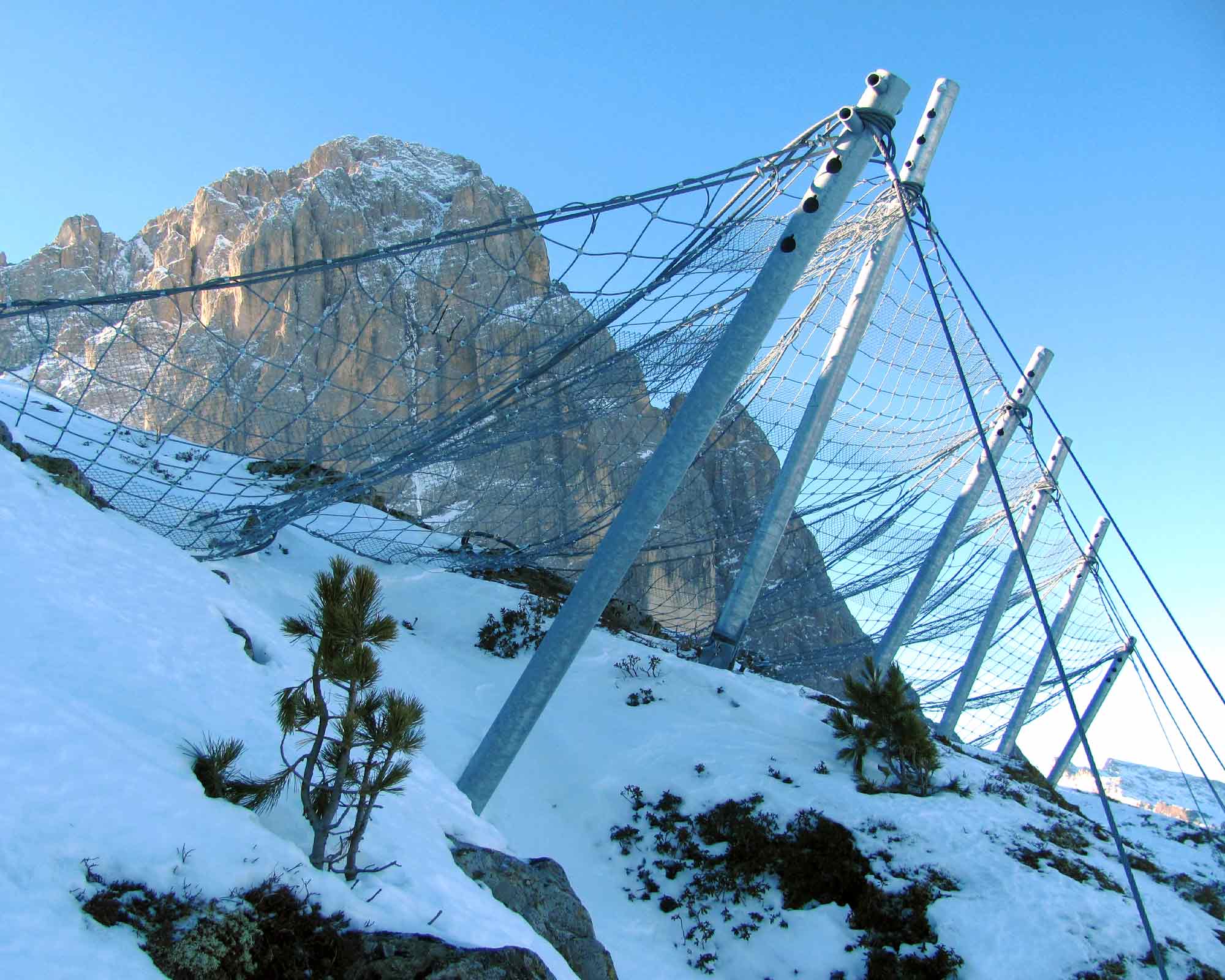Barring is to remove parts or fragments of rock at risk of detachment and fall. To define and plan the actions necessary to the safety of the rocky cliffs, Geovertical uses precise inspections with mountaineering techniques.
We operate several barring and demolition techniques:
-
- Demolition of unstable boulders with expansive;
- Explosive demolitions;
- Demolition with hydraulic jacks and manual crowbars.
Consolidation of rocky walls
The techniques and methods of intervention vary greatly according to the facilities or infrastructure to defend. The following are the different types of consolidation:
- Wall surface covering with a wire net with double twist adherence
- Covering with steel rope panels
- Geocomposite
- Ring panels
- Pannelli ad anelli concatenati
- Special nets. The special nets used by Geovertical are made of high strength steel wire, 2 mm, 3 mm or 4 mm, can be applied on virtually any type of slope, it is rocky ground or dissolved due to their high resistance (tractions in excess of 1770 N / mm²).
With the installation of these special nets Geovertical offers a proven method and certificate that provides maximum stability even in harsh environments.
Nailing
Nailing consist of structures made through laying of resistant elements (such as steel bars) laid in holes specially made in risk slopes. The drilling techniques and procedures for anchoring to the ground are defined according to the materials to be crossed. The specific specialized equipment, transportable by helicopter, are very strong but light enough to be used in the wall.
Defense from falling rocks
L’inGeovertical is specialized in the production of rockfall and snow barrier structures, laid on any land and under the most difficult conditions.
The barriers used by Geovertical to protect against rockfall phenomena are energy dissipating deformable structures with energy class ranging from 100 kJ to 5000 kJ.
The energy absorption capacity (serviceability and ultimate limit state) have been tested by national and international University institutes in the field equipped for vertical drop tests.
Works at height
The risk of avalanches and landslides often involves the urgent need to work on construction sites located at particularly high altitudes. This requires an experienced team of climbers and mountaineers, accustomed to working under extreme and adverse conditions. The facilities are specially designed, heli-transportable, positionable in any condition of slope and adapted to move in rough land.
There are mainly two types of barrier: snow nets located in rocky areas or areas without vegetation, and wooden racks positioned in green zones that allow the following reforestation and provide a natural protection even after a possible degradation of the barrier.
Natural Engineering
This term indicates the techniques used to reduce the risk of soil erosion in the consolidation works.
Such techniques include the use of live plants or parts of these (seeds, roots, cuttings), alone or in combination with inert natural materials (wood, stone or soil), biodegradable artificial materials (biomats, geojuta) or not biodegradable artificial materials (galvanized nets, geogrids, geonets, geotextiles).
Special structural works
It concerns the construction of works intended to transfer the loads of manufactured products resting on land unsuitable for carrying the loads themselves, of works designed to give the soil characteristics of resistance and non-deformability such as to make the tax of the manufactured products stable and to prevent geological instability , of works to make existing and functioning structures anti-seismic.
It includes, by way of example, the execution of poles of any type, underpinning, piling and special retaining walls, anchors, works to restore the static functionality of the structures, wells, works to ensure the stability of the slopes and of special processes for the drying up, waterproofing and consolidation of soils.
Railway and road sector
The interventions concern railway armament and road safety interventions.
The armament concerns the supply, installation and systematic maintenance or restructuring of the tracks for any railway, subway or tramway as well as braking and automation systems for goods sorting stations.
While, in order to guarantee the safety of the road vehicle flow, Geovertical deals with the installation, maintenance or restructuring of devices such as barriers, impact attenuators, fences and the like, aimed at containing and ensuring the road vehicle flow.
Belts for the transport of debris in the tunnel
The excavation of tunnels requires reliable solutions for the transport of the resulting material outside.
The use of belts allows limited energy consumption and programmable maintenance with reduced operating costs. The disposal of the mud with conveyor belts also avoids the use of heavy vehicles, promoting savings and safety both on the construction site and in the passage areas.
The tape, above all, in the external areas is armored with a cover that protects against possible falls of material.
Brenner Base photo gallery
Barring a rocky wall
Barring is to remove parts or fragments of rock at risk of detachment and fall. To define and plan the actions necessary to the safety of the rocky cliffs, Geovertical uses precise inspections with mountaineering techniques.
We operate several barring and demolition techniques:
-
- Demolition of unstable boulders with expansive;
- Explosive demolitions;
- Demolition with hydraulic jacks and manual crowbars.

Consolidation of rocky walls
The techniques and methods of intervention vary greatly according to the facilities or infrastructure to defend. The following are the different types of consolidation:
- Wall surface covering with a wire net with double twist adherence
- Covering with steel rope panels
- Geocomposite
- Ring panels
- Pannelli ad anelli concatenati
- Special nets. The special nets used by Geovertical are made of high strength steel wire, 2 mm, 3 mm or 4 mm, can be applied on virtually any type of slope, it is rocky ground or dissolved due to their high resistance (tractions in excess of 1770 N / mm²).
With the installation of these special nets Geovertical offers a proven method and certificate that provides maximum stability even in harsh environments.

Nailing
Nailing consist of structures made through laying of resistant elements (such as steel bars) laid in holes specially made in risk slopes. The drilling techniques and procedures for anchoring to the ground are defined according to the materials to be crossed. The specific specialized equipment, transportable by helicopter, are very strong but light enough to be used in the wall.

Defense from falling rocks
L’inGeovertical is specialized in the production of rockfall and snow barrier structures, laid on any land and under the most difficult conditions.
The barriers used by Geovertical to protect against rockfall phenomena are energy dissipating deformable structures with energy class ranging from 100 kJ to 5000 kJ.
The energy absorption capacity (serviceability and ultimate limit state) have been tested by national and international University institutes in the field equipped for vertical drop tests.

Works at height
The risk of avalanches and landslides often involves the urgent need to work on construction sites located at particularly high altitudes. This requires an experienced team of climbers and mountaineers, accustomed to working under extreme and adverse conditions. The facilities are specially designed, heli-transportable, positionable in any condition of slope and adapted to move in rough land.
There are mainly two types of barrier: snow nets located in rocky areas or areas without vegetation, and wooden racks positioned in green zones that allow the following reforestation and provide a natural protection even after a possible degradation of the barrier.

Natural Engineering
This term indicates the techniques used to reduce the risk of soil erosion in the consolidation works.
Such techniques include the use of live plants or parts of these (seeds, roots, cuttings), alone or in combination with inert natural materials (wood, stone or soil), biodegradable artificial materials (biomats, geojuta) or not biodegradable artificial materials (galvanized nets, geogrids, geonets, geotextiles).

Special structural works
It concerns the construction of works intended to transfer the loads of manufactured products resting on land unsuitable for carrying the loads themselves, of works designed to give the soil characteristics of resistance and non-deformability such as to make the tax of the manufactured products stable and to prevent geological instability , of works to make existing and functioning structures anti-seismic.
It includes, by way of example, the execution of poles of any type, underpinning, piling and special retaining walls, anchors, works to restore the static functionality of the structures, wells, works to ensure the stability of the slopes and of special processes for the drying up, waterproofing and consolidation of soils.

Railway and road sector
The interventions concern railway armament and road safety interventions.
The armament concerns the supply, installation and systematic maintenance or restructuring of the tracks for any railway, subway or tramway as well as braking and automation systems for goods sorting stations.
While, in order to guarantee the safety of the road vehicle flow, Geovertical deals with the installation, maintenance or restructuring of devices such as barriers, impact attenuators, fences and the like, aimed at containing and ensuring the road vehicle flow.

Belts for the transport of debris in the tunnel
The excavation of tunnels requires reliable solutions for the transport of the resulting material outside.
The use of belts allows limited energy consumption and programmable maintenance with reduced operating costs. The disposal of the mud with conveyor belts also avoids the use of heavy vehicles, promoting savings and safety both on the construction site and in the passage areas.
The tape, above all, in the external areas is armored with a cover that protects against possible falls of material.
Brenner Base photo gallery








